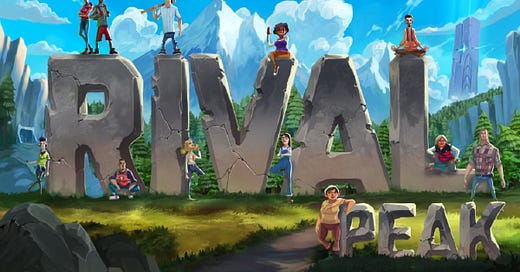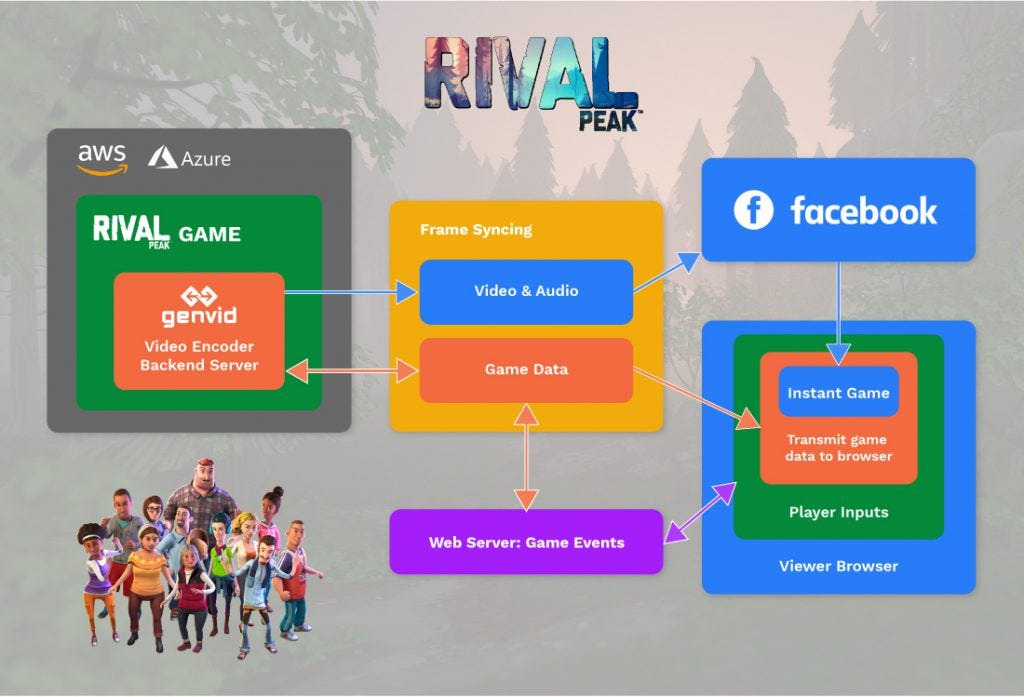One thought for the week 💭
Massive Interactive Live Events (MILEs) are the future of entertainment
[850 words - 3 minute read]
In December, Facebook announced the launch of a quasi-reality gameshow called Rival Peak. It is so anomalous that it can be difficult to fully grasp. There is a Big Brother aspect to it. 24 hours a day, 7 days a week, viewers can watch 12 virtual characters controlled by AI that have been dropped into a forest in America's Pacific Northwest to fend for themselves. However, there is also a game aspect to it. Billions of viewers (anyone with a Facebook account) can influence the characters’ decisions and interfere with the world in real-time using taps and clicks. These decisions can be either collective or individual and can influence numerous aspects of Rival Peak in ways both big and small.
Rival Peak is the first true example of a ‘MILE,’ or ‘Massive Interactive Live Event’. MILEs combine elements of (i) unscripted television; (ii) massively multiplayer games; and (iii) mass audience participation. Viewers of a MILE can watch the event via a video stream. However, every viewer can also influence the progression of the story in real-time by interacting with the stream in various ways.
A common analogy used to describe MILEs is The Hunger Games. In this, the audience votes and sends items into the live game to aid their favourite hero or create challenges for their opponents. Another (incorrect) analogy is Netflix’s Bandersnatch. This is not a MILE. Unlike MILEs, Bandersnatch is:
Pre-determined - not unscripted.
On-demand - not live.
Private - not public.
The only comparable event to Rival Peak was Twitch Plays Pokémon in 2014 - an intriguing experiment in social collaboration, during which more than one million people completed the game by collectively interacting with a Twitch livestream.
A feat of engineering
MILEs of Rival Peak’s scale and sophistication have only recently been made possible due to the latest developments in AI, cloud, LiveOps and streaming technology. In the case of Rival Peak, most of this infrastructure was built by the scale-up Genvid. Specifically, to achieve mass interactivity, Genvid had to create software to timecode gameplay and video streams and then synchronise them seamlessly. It also developed a web interface and a full cloud gaming backend supported by AWS instances. The combination allows video streams to become truly interactive (click the stream and things happen within the underlying content). MILEs also require sophisticated AI to power the characters. In the case of Rival Peak, Pipework Studios built a proprietary AI system which enables characters to switch between goals opportunistically, plan for the future, weight plans based on personal (and viewer-driven) preferences, explore when other goals and plans aren’t immediately available, and much more.
Why are MILEs interesting?
Despite this technical complexity, MILEs are still very nascent. Nonetheless, in my view, they have the potential to become one of the largest categories of entertainment over the next five years. Given the category did not exist before this year - this would be explosive growth.
The reason for being so bullish is that relative to existing categories, MILEs have:
A larger TAM: MILE’s cater to a huge range of users. There is room for highly engaged, ‘hardcore’ gamers - participating in intense gameplay that is akin to MMORPGs like League of Legends. However, in the same MILE, there is also room for hyper-casual gameplay that can be enjoyed while cooking, cleaning, or working. This kind of ‘laid-back’ gameplay is more akin to watching TV than playing games. Because of this vast spectrum of interactivity, MILEs are likely to have a much broader appeal than both television and gaming.
Lower friction: MILE’s are a cloud-native experience. They can be streamed on any device with access to the internet, which makes them highly accessible. However, they don’t suffer the same technical challenges that other cloud games do. This is because MILEs only require one simulation. Certain MILEs may require a few dozen simulations. But this is considerably less than the millions of unique simulations that are required by other forms of cloud gaming. This feature allows MILEs to deploy incredibly sophisticated AI and rich simulations while ensuring real-time synchronisation and avoiding network and home infrastructure-related issues.
Stronger network effects: The strength of a product’s network effects are determined by a number of factors. However, two of the most critical are (i) the number of nodes (participants) in the network; (ii) the density of the network - which is the ratio of links to nodes. Given the larger TAM and lower friction discussed above, the number of potential nodes in any given MILE should be higher than in other categories such as MMOs (all things equal). Meanwhile, the social elements and low friction interactivity enable strong links between all the nodes - creating a potential density comparable to social media.
There is a long history of new technology creating entirely new genres and formats. MILE technologies remove the barriers between static, noninteractive media and interactive entertainment. This yields a content type that has the potential to have greater appeal than anything that has ever preceded it.
Moreover, the combination of several adjacent technologies takes the experience of MILEs to a completely new dimension. For example, imagine combining MILEs with (i) conversational AI and synthetic voice; (ii) hyper-realistic synthetic humans; (iii) VR/MR; (iv) UGC / sandbox creation; (v) virtual economies.
This kind of entertainment - although seemingly alien and incongruous - could be a reality within the next five years.
News from this week 🗞
Gaming 🎮
SplashLearn, a 10-year-old edtech startup that teaches children through a game-based curriculum, has raised $18 million. The startup offers maths and reading courses to young students. It has developed, with guidance from teachers and other experts, over 4,000 games and other interactive activities to explain various concepts to the children. Link
Powder, a French startup that allows users to share video game clips has raised a $14m Series A led by Serena. While many communities of gamers already share content on Twitch, Discord and Reddit, there isn’t a dominant mobile app focused on gaming. Link
France’s Homa Games has raised $15 million to enhance its factory for building hypercasual mobile games. This represents a large seed round for Europe. The publisher and developer already has more than 30 apps and games in its portfolio with >250 million lifetime downloads since it was founded in 2018. Link
Audio 🎧
Audio app Podz launches to turn podcasts into a personalized audio newsfeed. The problem the startup aims to solve is straightforward. Because podcasts often consist of 30 or 60 minutes or more of spoken-word audio, they’re difficult to browse, and when you discover new ones, it’s usually through word-of-mouth recommendations or clunky search tools. While tools like Headliner make it easier for podcasters to promote their content with short clips on social media, Podz automates that creation process and makes those clips the centerpiece of the listening experience. Link
AR/VR/MR 🕶
Copenhagen-based Labster, an edtech startup that sells virtual science laboratory simulations to schools, has raised $60M in its Series C. The round brings Labster’s total capital raised to $100M. The round was led by Andreessen Horowitz. Labster works in collaboration with over 2,000 colleges, universities, and high schools including MIT, Yale, ETH Zürich, the University of Cambridge, and Imperial College. Link
Apple launches a new AR experience tied to ‘For All Mankind’. “For All Mankind: Time Capsule” is a new augmented reality app created by Apple to promote the upcoming second season of “For All Mankind,” which premieres on February 19 on Apple TV+. The app is noteworthy as another sign of Apple’s interest in AR, even beyond the reports that it’s working on AR glasses.
Video 📹
Knowledge hacking app Uptime raises £11.5m. Uptime presents expertly curated five-minute Knowledge Hacks of the world’s best books, courses, and documentaries. The essence and actionable insights of knowledge from these sources are then distilled into five-minute ‘Hacks’. Each one is designed to keep users informed, entertained and inspired while saving them time, effort and money. Link
Reduct.Video raises $4M to simplify video editing. Despite the proliferation of streaming video platforms and social media apps on the consumer side, video remains “underutilized” in a business context, because it simply takes so much time to sort through video footage, much less edit it down into something watchable. Reduct uses artificial intelligence, natural language processing and other technologies to simplify the process by automatically transcribing video footage (users can also pay for professional transcription), then tying that transcript to the video. Link
Other 🤷♂️
Reddit raises $250m at a $6bn valuation. Reddit now has >50m DAUs. It was valued at $3 billion in its last round in February 2019. The surge in its value follows a 90% jump in advertising revenue from a year ago. Link
Interesting data from this week 📈
New entrants are outspending most legacy content manufacturers
Source: Morgan Stanley via Benedict Evans
Thank you for reading ✌️






